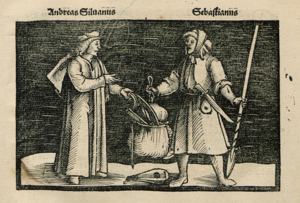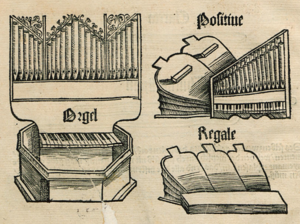Sebastian Virdung

Sebastian Virdung (~1465 - between 1512 and 1517) was a German composer. He is the author of Musica getutscht und aussgezogen, one of the earliest musical treatises in a vernacular language, most of which consists of descriptions and illustrations of musical instruments.
Biography
In the 1480s, Virdung was noted as studying law at Heidelberg University while also performing as a singer at the chapel of Count Philip. In 1500, he was made chaplain at Stalburg Castle, in 1505, he was employed in Stuttgart, and by 1507, he had found his way to Konstanz Cathedral, from where he was dismissed the following year. Throughout the later years of his life, he worked on a German-language general-purpose musical treatise, but was only able to secure enough funding to publish a part of the unfinished work in 1511. After his death, an expanded Latin adaptation was published by Othmar Luscinius under the title Institutiones musicae.
Works

Virdung's surviving oeuvre consists of five four-part songs (four published in 1513 by Peter Schöffer) and two alto parts to existing songs by Paul Hofhaimer and Erasmus Lapicida (published in 1539 by Johannes Petreius). The fifth song, O haylige, appears in Musica getutscht to demonstrate the process of intabulation using tablature systems for lute and keyboard. Rather than idiomatic instrumental arrangements, Virdung presents literal transcriptions of the song, ostensibly for pedagogical purposes. The resulting awkwardness, as well as the general lack of quality in the song itself, was criticised by Arnolt Schlick (highly skilled both as an organist and as a lutenist) in the preface to his publication, Tabulaturen Etlicher Lobgesang. The system of tablature used by Virdung differs from all other surviving examples in that it places the boundary of octaves at E-F; the reason for this is unclear, but it may have been done to evenly divide the F-f `` organ keyboard, itself based on the range of the gamut, into three octaves rather than four incomplete ones. However, when writing out scales to demonstrate aspects of the tablature notation, Virdung also divides octaves at F-G and G-A.
References
Bullard, B. (2001). Virdung [Grop], Sebastian. in: Grove Music Online.
Lenneberg, Hans H. (1957). The Critic Criticized: Sebastian Virdung and his Controversy with Arnold Schlick. Journal of the American Musicological Society, vol. 10.